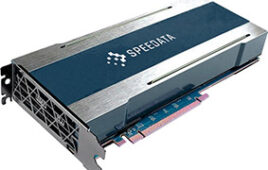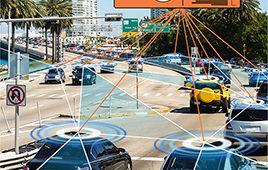Prestigious Cherry Award Goes to NREL Scientist

Enlarge image
National Renewable Energy Laboratory post-doc, John Simon, left, and NREL Principal Scientist, Jerry Olson, right, view test materials in a molecular beam epitaxy (MBE) reactor in their lab at the Solar Energy Research Facility at NREL in Golden, Colo.
Credit: Dennis Schroeder
A physicist from the U.S. Department of Energy’s National Renewable Energy Laboratory who was a pioneer in multi-junction solar cells for use in outer space and on planet Earth has been awarded the prestigious Cherry Award by the Institute of Electrical and Electronics Engineers (IEEE).
Jerry Olson, a principal scientist at NREL, received the award at the IEEE’s annual Photovoltaic Specialists Conference in Seattle.
Olson pried open the door for multijunction solar cells by showing that a top cell of gallium indium phosphide and a bottom cell of gallium arsenide can capture and convert photons more efficiently into electricity than previous attempts at using other materials.
He and his coworkers showed that the multijunction concentrator cells not only use a fraction of the precious electronic materials used by the thicker flat plate cells, but that they can capture more light through the course of a day.
Olson’s breakthrough was embraced by NASA, which uses multi-junction solar cells based on his invention to power most space satellites as wells as the Mars rovers Spirit and Opportunity.
To come up with the ideal materials to make a highly efficient solar cell requires an almost slavish attention to the Periodic Table of Elements, as well as a mastery of physics and good instincts.
From Utah with a Saxophone

Enlarge image
This close-up shows a stack of plates with wafers being prepped for coating in the molecular beam epitaxy reactor (MBE) at NREL. The MBE deposits semi-conductor materials on the plates.
Credit: Dennis Schroeder
That those skills were embodied in Olson, who started out college as a music major, is all the more intriguing.
He grew up in Utah playing the saxophone. Even after he switched from music to physics at the University of Utah, it wasn’t until years later “that I could even spell ‘photovoltaics,'” Olson said.
Despite the inauspicious start, Olson in 1978 landed a job at the fledgling Solar Energy Research Institute in Golden, Colo., the precursor to NREL. His assignment: to purify silicon.
He did that for a few years, patenting a new method for refining silicon. Then, in 1982, a change of emphasis switched priorities away from silicon cells and to new materials.
“At first I was kind of miffed that we wouldn’t be allowed to develop some promising ideas, but I also know that change is sometimes good,” Olson recalled.
Turning Photons into Currents of Electrons

Enlarge image
NREL research technician Waldo Olavarria, left, changes a quartz reactor tube in the atmospheric reactor as NREL Principal Scientist, Jerry Olson, right, watches.
Credit: Dennis Schroeder
Solar cells work by converting photons into electrons capable of producing electrical power. This can happen in a class of materials called semiconductors. In the dark, most electrons in a semiconductor are confined to the valence band where the electrons are bound to individual atoms and are not free to move. Semiconductors also have what is called a conduction band where electrons are free to move. But an electron can only occupy the conduction band if it receives energy from another source, such a photon. The photons must have energy equal to or greater than the so-called band gap between the conduction band and valence band of the semiconductor.
Solar cells convert absorbed sunlight to electrical power such that the current is proportional to the number of electrons that jump the band gap and the voltage is proportional to the band gap energy.
A single-junction solar cell has just one band gap. Scientists try to tune the size of that gap to maximize power conversion efficiency. But this is always a balancing act. If the gap is too wide, the low-energy photons can’t make the leap and current is low. If it’s too narrow, it’s wasting the potential of the high-energy photons, which shed their excess energy as heat when they make the too-easy jump across the gap.
Multi-junction cells, with more semiconductor layers, have more band gaps, and more of an opportunity to fine-tune the size of those gaps.
Still, the enigma was how to choose the perfect combination of materials that matched up in current, lattice and band gaps so the whole solar cell would maximize efficiency.
The New Kid Finds a New Way
Olson, the rookie in multi-junction solar cells, looked at some papers on the subject and had a brand new thought. Most groups working in the field were looking for band gap combination that would yield maximum theoretical efficiency with less emphasis on the chemical and structural compatibility of the different semiconductor layers.
In essence they were “trying too hard to hit the bull’s eye,” Olson said.
The key was to set their sights lower and find materials that were compatible (and more likely to be manufacturable) but still had a band gap combination that would give a high, but not necessarily the highest, theoretical efficiency. That combination was a top cell of GaInP with a band gap of 1.9 eV and a bottom cell of GaAs with a band gap of 1.4 eV. These two semiconductors are chemically compatible and they have the same lattice constant, a measure of their structural compatibility.
The first cells in 1985 were fairly anemic with efficiencies less than 10 percent. But as the understanding and the processes improved, efficiency skyrocketed. The cells set several world records at about 30 perent in 1994 and 1995. After that the NREL team and other groups around the world started adding additional semiconductor junctions and the world record steadily increased to where it now stands at 43.5 percent.
Cherry Award Given for Body of Work

Enlarge image
NREL Principal Scientist Jerry Olson holds a wafer that contains 11, diagnostic solar cells to be tested at NREL. The cells are used with a solar concentrator and are 3 microns thick. They convert more than 20 percent of the photons that hit them into usable electricity.
Credit: Dennis Schroeder
The Cherry Award is named in honor of William R. Cherry, a founder of the photovoltaic community. In the 1950s, he was instrumental in establishing solar cells as the ideal power source for space satellites and for recognizing, advocating, and nurturing the use of photovoltaic systems for terrestrial applications. The William R. Cherry award was instituted in 1980, shortly after his death. The purpose of the award is to recognize an individual engineer or scientist who devoted a part of their professional life to the advancement of the science and technology of photovoltaic energy conversion.
It is only awarded to scientists who are still actively contributing to the field.
Today’s PV concentrators, which can extract 30 to 40 watts out of a small one square centimeter solar cell by using lenses to focus the power of a thousand suns on the cell, are direct descendants of Olson’s multi-junction breakthrough.
Olson Could Learn from Other’s Mistakes
Sarah Kurtz, NREL’s acting director of the National Center for Photovoltaics, joined the lab a couple years after Olson’s watershed invention, and the pair has been instrumental in clearing hurdles to ensure that the GaInP/GaAs solar cell remains the top cell for efficiency.
“He told me that he was looking at the (Periodic) Table and noticed that the Gallium Indium Phosphide and Gallium Arsenide would be a good combination,” Kurtz said. “At the time the understanding was that that combination would separate and produce low-quality material.
“Jerry wasn’t dissuaded by things in the literature that might give erroneous directions,” Kurtz said. “The brilliance of his achievement was partly that he was willing to set that aside even in the face of people telling him that his approach would never work.”
When his first efforts produced a low-efficiency cell, he wasn’t discouraged because he knew that the purity of indium could be ramped up quickly if industry could see the advantage.
“Jerry has always liked looking at the other side of things that people are working on and coming up with the wrong conclusions,” Kurtz said.
Ryne Raffaelle, outgoing director of NREL’s NCPV said Olson’s work on solar cell materials “established him as one of the true icons of our field.”
“It is working with people like Jerry, and the appreciation I have for their tremendous contributions to the field of photovoltaics that make it truly an honor to be associated with our National Center for Photovoltaics.”
Olson Sees Bright Future for Solar

Enlarge image
NREL Principal Scientist, Jerry Olson holds one of the first multi junction cells that were developed in the 1980s from his technology
Credit: Dennis Schroeder
Olson now plays the saxophone only at Christmas. He and his wife enjoy bicycling hundreds of miles in places such as northern Spain, Southeast Asia, and Mexico.
The solar industry has made tremendous progress in increasing efficiency and lowering costs, but still faces big hurdles because the cost of energy from other sources are so low, Olson said.
“In the long term, we are going to run out of fossil fuels,” he said. “Solar is going to be a very big component of clean energy. It will play an important part in how the world operates in the future.”
He believes the future will belong to the PV concentrators, based on the multi-junction solar cells.
“We won’t be covering square miles with precious or toxic materials,” he said. “Concentrators are going to have a big role. Probably not on roofs, but in subdivisions or in large utilities, especially in sunny areas.”
Olson is a principal scientist in the III-V Materials and Devices Group at NREL. The past quarter century, his group has developed and refined the multijunction solar cell, won several patents, and transferred licenses to industry. Besides world records in efficiency, the group has won several awards, including two R&D 100 Awards in 1990 and 2001, a Federal Laboratory Consortium Award for Technology Transfer in 1997, the IEEE Electrotechnology Transfer Award in 1998 and the Dan David Prize in 2007.
The most enduring legacy are the devices based on Olson’s original GaInP/GaAs solar cell now being produced by companies around the world for space power and concentrator photovoltaic systems.
Learn more about solar energy research at NREL.
— Bill Scanlon




